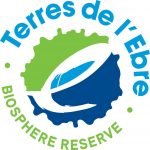Terres de l’Ebre is a small, very beautiful region of southern Catalonia, Spain.
For cyclists considering Catalonia cycling trips and cycling holidays in Catalonia, it’s probably not the first region they will hear about.
That’s a shame – because it’s ideal for many kinds of cyclist, with beautiful riding and a diverse landscape. It includes two separate Natural Parks, with two different ecosystems in just over 30 kilometres and in 2013 it was made a UNESCO Biosphere Reserve.
Why go cycling in Catalonia’s Terres de l’Ebre?
One day you could be riding miles of flatlands along the coast, and the next, be riding high in the mountains. Each is easily within reach of a 100km loop. With the mountains even visible from the delta, Terres de l’Ebre is a great choice for those looking for cycling tours in Catalonia.
In this article, we speak to Anna Vendrell, a local cyclist who also runs We Feel Events, organising and promoting cycling events in Catalonia. Anna knows Terres de l’Ebre inside out.
Overview of Terres de l’Ebre (for cyclists)
Geography of the region
Terres de l’Ebre is located in the southwest corner of Catalonia, Spain. It’s situated in the southern area of the river Ebre and in 2013 was awarded UNESCO Biosphere Reserve status. To the north lies Barcelona and above it is Girona. Terres de l’Ebre may not be as familiar as those two “big” names, but it holds a charm that appeals to cyclists.
The flatter areas of Terres de l’Ebre are located south of the river, typically where you will find the region’s impressive rice fields. All around the river you’ll also find irrigated land that’s home to farms growing vegetables and fruit trees. This area is great for recovery day rides or for a warm up ride when you arrive.
Further inland are some gorgeous villages, like Miravet, with its vineyards, almond and olive trees. They are situated around more rolling terrain.
The mountains are further inland again.

Overview of the geography and terrain of Terres de l’Ebre. Brown areas are the high hills/mountains, green area is the flat lands.
What are the roads like when cycling in Terres de l’Ebre?
Like much of Spain, cyclists are treated with respect here. There are lots of small roads around the region and so drivers often encounter cyclists and thus tend to be patient when waiting to safely get past.
The roads are generally in good condition, making cycling in Terres de l’Ebre quite easy going on your road bike. The asphalt is smooth and not like the patchwork roads seen elsewhere in the world! With lots of small, quiet roads there are plenty to choose from, but be aware of the motorways and higher capacity roads such as AP-7 when plotting your routes. These should be avoided at all costs.
In terms of cycling infrastructure, there is one particular traffic-free cycle path of note, the Zafán Valley Green Way (via Verde Val de Zafán). Via Verde Zafán runs from Aragon to Tortosa, along a disused railway line and is completely free from cars. It’s 180km long, so decent enough to do over a couple of days or to use it as a way to get between towns.
There are also plenty of signposted routes around the Delta de l’Ebre Natural Park. The official website offers maps so you can identify which route you want to ride, but they are all signposted within the park so it’s easy to follow along! You can find the routes here.
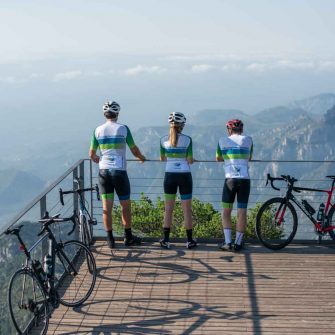 Views from Caro observatory, Els Port Natural Park
Views from Caro observatory, Els Port Natural Park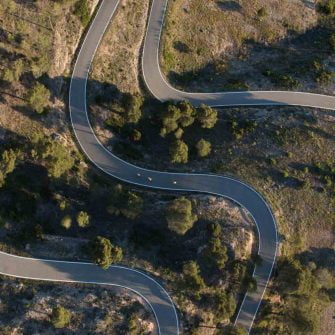 Incredible smooth asphalt in this region
Incredible smooth asphalt in this region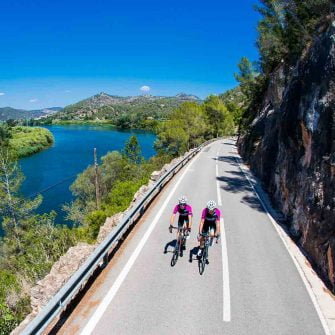 From Tivenys to Benifallet, cycling along the river
From Tivenys to Benifallet, cycling along the riverTerres de l’Ebre’s cycling routes
What are Terres de l’Ebre’s must-do cycling climbs/routes?
Terres de l’Ebre is home to some of Catalonia’s most beautiful cycling routes. The tourism board has prepared some cycling routes to give cyclists a starting point for the best roads to ride. These are not signposted, but should be simple to follow if you have a cycling computer.
You can find all the routes here.
Of these, the three I would choose are below.
Grand Tour Terres de l’Ebre
Distance:
206 kilometres
Elevation gain:
4,472 metres
What to expect:
The Grand Tour Terres de l’Ebre is one of the toughest routes in the region.
It takes in three demanding climbs before heading to the final ascent, Mont Caro. Mont Caro is one of the hardest cycling climbs in Catalonia, despite its positively Mediterranean climate. Expect plenty of switchbacks and stretches with a gradient that’s over 10%. There are spectacular views on the way up and from the top too, with vistas all the way back over the mountains and towards the coast.
Throughout the 206-kilometre route, you’ll see a variety of landscapes, including incredible views of the Delta del Ebre, as well as testing yourself to the limit with 4,472 metres of elevation gain. It’s not one for the faint-hearted!
As a circular route, you can start from any point, but the official route starts and ends in Tortosa.
Why it’s special:
Stunning vistas of mountains and green lush river valleys are among the reasons you should try this route.
 Climbing Mont Caro
Climbing Mont Caro Ulldecona reservoir
Ulldecona reservoir Cycling in the clouds at Caro observatory!
Cycling in the clouds at Caro observatory!A tour around Ebro Delta Natural Park
Distance:
110 kilometres
Elevation Gain:
536 metres
What to expect:
If you want to discover just why the region was awarded UNESCO Biosphere Reserve status, then this route is for you. Full of varied terrains, it traverses the natural park of the Delta de l’Ebre. It may not be particularly challenging climbing wise, with just 536 metres of elevation gain over 110 kilometres, but the views make up for the lack of ascents.
The official start is at La Sénia, but it’s circular so you can begin anywhere on the route. There is plenty to see as you head through lagoons of the Delta, rice fields, and you may even spot some interesting birds.
Be aware that there’s little shade so this route is best avoided in the height of summer.
Why it’s special:
Depending on the time of year you ride, the colours you see will be very different, and that’s what makes this part of Spain so beautiful and interesting.
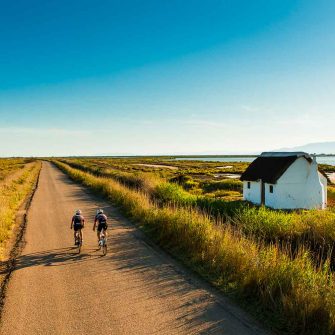 Ebro Delta Natural Park, cycling next to a barraca (a typical building in Ebro Delta)
Ebro Delta Natural Park, cycling next to a barraca (a typical building in Ebro Delta) River channels in Ebro Delta Natural Park
River channels in Ebro Delta Natural Park Rice fields in Ebro Delta Natural Park
Rice fields in Ebro Delta Natural ParkBattle of the Ebro Landscape
Distance:
98 kilometres
Elevation Gain:
1,747 metres
What to expect:
History buffs may recognise the Ebro’s significance in the Spanish Civil War, and this route heads through some of these areas of historical significance. Beginning in Ascó, (although you can start from anywhere en route), the ride passes through the Ribera forests, before heading to the Berrús heritage area.
It features plenty of undulation, with some challenging climbs to test your legs while you take in the breathtaking scenery of the region. You’ll also get the chance to ride past some of the vineyards.
Why it’s special:
Soak up the history and enjoy the silky smooth roads with this testing route.
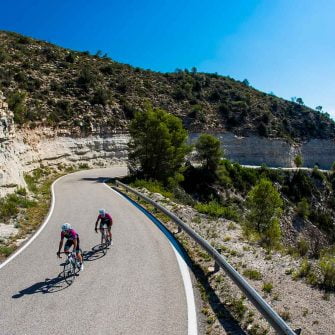 Between La Pobla de Massaluca and Riba-roja d’Ebre
Between La Pobla de Massaluca and Riba-roja d’Ebre Between Flix and Vilalba dels Arcs
Between Flix and Vilalba dels Arcs Cycling next to Riba-roja d’Ebre reservoir
Cycling next to Riba-roja d’Ebre reservoirWhat are the key road cycling events in Terres de l’Ebre?
The region is not a stranger to the pro cycling world. La Volta Catalonia cycling race has visited a number of times and used the ascent to Mont Caro as a final stage some years ago.
In terms of events, Terres de l’Ebre is an up and coming area for cyclo-tourism, so there aren’t yet many well-established road cycling events for amateurs.
We Feel Events began operating in 2020 and has developed three events that will be running on an annual basis. Each offers a unique viewpoint of the region, and there’s even a gravel ride thrown in for good measure.
Challenge Cycling Terres de l’Ebre
This unique event takes place over seven stages, which the participants can complete in their own time between September and November. You don’t have to complete all stages, just as many as you feel capable of. However, if you complete all of them, you are entered into a raffle to win various prizes such as a t-shirt or even a trip back to the region.
The seven stages consist of 979 kilometres, and over 14,000 metres of elevation gain so it’s not something you can rock up to without training! The official website here has more information detailing each stage for the 2021 edition. Some of the routes we mentioned before are part of this challenge, as each stage aims to showcase a different part of the region.
 Lots of vineyards to explore in Terres de l’Ebre
Lots of vineyards to explore in Terres de l’Ebre Switchbacks of Mont Caro
Switchbacks of Mont Caro Relaxing by the sea
Relaxing by the seaGran Fondo Terres de l’Ebre
This event is for road cyclists, as per by the name Gran Fondo. In 2021 they had to cancel the event due to Covid, but they hope to put the event back on for 2022.
Note: The information here is representative of the 2021 edition before it was cancelled. Please check the organiser’s website for up to date details on when the 2022 event is scheduled.
In 2021 the event was scheduled for 16 October. This is the last part of the usual tourist season when the temperatures begin to drop but are not yet too cold.
There were two route choices, one at 148 kilometres with 2,191 metres of elevation gain and one at 100 kilometres with 791 metres of elevation gain.
The 148-kilometre course takes in the infamous Mont Caro, but with a twist – it’s timed! So this is ideal for anyone wanting to try a mountain time trial. The 100-kilometre route is still challenging, but focuses more on the wonderful scenery of the region and traversing wine territories.
La Garba
First run in 2021, this gravel and mountain bike friendly event will be held again in March 2022. It offers three choices of routes, and they aren’t made available to the riders until 24 hours before the event, so you don’t know where you’ll be riding!
You can guarantee it’ll be beautiful though, as it takes in parts of the Biosphere Reserve.
The three route choices are as follows: The Manoll, at 70 kilometres and 35 metres of elevation, La Garba, at 120 kilometres and 50 metres of elevation, and The Goat, at 230 kilometres and 3600 metres of elevation.
The event caters to all abilities and showcases some of the best landscapes in the region.
 Gravel roads of the La Garba event
Gravel roads of the La Garba event Lots of variety on the routes
Lots of variety on the routes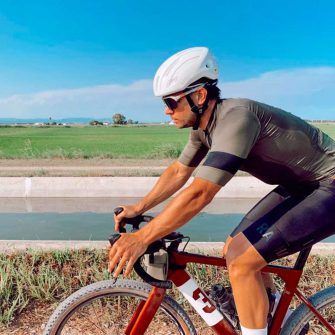 Gravel riding in the river delta
Gravel riding in the river deltaWhat are the best hotels and accommodation options for cyclists in Terres de l’Ebre?
Which towns to base yourself in
Tortosa
Tortosa is a great place to base yourself for a cycling holiday in Spain’s Catalonia, as it is brimming with culture. It’s right in the middle of the two extremes of landscape, with Mont Caro to the west and the beach 23km to the right, so you have plenty of choices when it comes to road cycling routes.
Amposta or l’Ametlla de Mar
If you’re after something more leisurely and want to be close to the beach for your Catalonia cycling tour, then Amposta or l’Ametlla de Mar are ideally situated. You can head further inland on a morning ride and then relax on the beach in the afternoon!
Gandesa
A final place to consider is Gandesa. This town is part of the wine region, so it’s perfect if you’re into your vino. It’s quite far north in Terres de l’Ebre so you can expect more rolling terrain around this area.
 La Suda Castle (Parador de Turismo) in Tortosa
La Suda Castle (Parador de Turismo) in Tortosa Old railway bridge over the Ebro river in Tortosa
Old railway bridge over the Ebro river in Tortosa Pinell de Brai Cooperative Wine Cellar
Pinell de Brai Cooperative Wine CellarCyclist-friendly accommodation in Terres de l’Ebre
[bike-storage-reminder]
The towns of l’Ametlla de Mar, Amposta and Tortosa have cyclo tourism certificates, but the region doesn’t have any sort of ‘cyclist friendly’ lists of accommodation for you to check online. It’s best to check with individual hotels before booking that they can accommodate both you and your bikes.
That said, one cyclist-friendly hotel that we do know of is the Hotel SB Corona in Tortosa. They sponsor the Gran Fondo event and are specialists in cyclo-tourism. They also offer services such as bike storage with video surveillance and can offer mechanical help within the hotel.
 Pool at Hotel SB Corona (credit: Hotel SB Corona Tortosa)
Pool at Hotel SB Corona (credit: Hotel SB Corona Tortosa)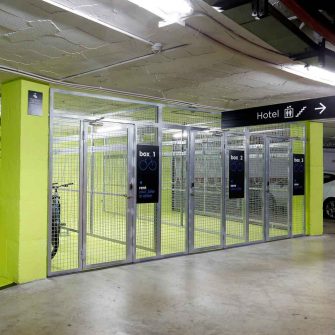 Bike storage at Hotel SB Corona (credit: Hotel SB Corona Tortosa)
Bike storage at Hotel SB Corona (credit: Hotel SB Corona Tortosa) Bike wash facilities at Pool at Hotel SB Corona (credit: Hotel SB Corona Tortosa)
Bike wash facilities at Pool at Hotel SB Corona (credit: Hotel SB Corona Tortosa)In Poble Nou, the hotel L’Algadir del Delta is known to be cyclist-friendly and is on the doorstep of some great Catalan cycling routes including cycling routes such as the routes around the Delta de l’Ebre Natural Park. They offer many services for cyclists including a bike cleaning area, a shower area, mechanical assistance on-site, enclosed and outdoor parking for bikes and a store where you can top up on essentials like inner tubes. They also offer bike hire and special ‘athlete’ menus in their restaurant.
 Pool at Hotel L’Algadir del Delta (credit: Hotel L’Algadir del Delta)
Pool at Hotel L’Algadir del Delta (credit: Hotel L’Algadir del Delta) Bedroom at Hotel L’Algadir del Delta (credit: Hotel L’Algadir del Delta)
Bedroom at Hotel L’Algadir del Delta (credit: Hotel L’Algadir del Delta) Bike room at Hotel L’Algadir del Delta (credit: Hotel L’Algadir del Delta)
Bike room at Hotel L’Algadir del Delta (credit: Hotel L’Algadir del Delta)
Are there places for bike hire/bike shops in Terres de l’Ebre?
Prices, services and bike brands often change. Please let us know if anything is incorrect.
Cycling tourism is still in its infancy in Terres de l’Ebre and the area is rural. There aren’t tons of bike shops – you’ll probably have to head to Cambrils or Tarragona if you need road bike hire (see list below).
Bike hire
Bike Cambrils
Bike Cambrils
Avd. Diputación, 185
43850 Cambrils (Tarragona)
Bike Cambrils offers a variety of bikes, from road to mountain to electric. They also have a workshop and shop if you need it while you’re cycling Catalunya.
Eitzinger
Eitzinger Bike Station Cambrils offers bike hire, bicycle repair, and has an onsite shop. Prices for rental start from €40 per day for a road bike with Shimano Ultegra.
Marine Bicycles
Pg. Sant Joan Baptista la Salle, 15
43850 Cambrils (Tarragona)
and
Av. Principat d’Andorra, 7
43002 Tarragona
Marine Bicycles has two stores you can choose to hire bikes from. They also have a showroom for you to purchase accessories or consumables like inner tubes. The road bikes they have for hire include carbon road bikes and prices start from €36 per day with a €100 refundable deposit.
Rodabike
Cr. de Santa Joaquima de Vedruna, 27 43850 Cambrils
Rodabike offers a variety of bikes for hire, with road bike hire starting at €33 per day not including pedal or helmet hire or insurance. They also have a workshop.
Cycling Costa Daurada
Camí del Mas de Clariana, S/N
Cambrils 43850
Cycling Costa Daurada offers some high-end bike choices, like Argon 18 bikes. They can be rented for €46 per day, and you can even ask them to drop off the hire bikes at your hotel or accommodation. They also offer cycling holidays in Catalonia.
Bike shops in Terres de l’Ebre
There’s a long list of bike shops here; we’ve highlighted a few below.
Bicisports Aubanell
Reis Catòlics, 3
43780 Gandesa, Gandesa
This is a family run business that offers cycle hire and can drop the bikes off at your hotel. They seem to only offer mountain bikes, so bear that in mind if you’re wanting to travel longer distances on road.
Deltacleta
Masia de la Torra. Crta. TV-3451 km3,1
43580 Deltebre, El Baix Ebre, Tarragona, Catalunya
This shop offers electric bicycle hire, and costs from 24€ per person. It operates in the Ebro Delta Natural Park and includes GPS systems and saddlebags so you don’t need to wear rucksacks.
L’esplai Ciclista
Polígon Pla de l’Estació, 4
43500 Tortosa, Tarragona, Catalunya
Located in Tortosa, L’esplai Ciclista has a bicycle workshop and offers repair, maintenance as well as bicycle hire. They stock road bikes from well known brands, and they’re well equipped to help with any queries you may have about the Baix Ebre Green Trail, Route 10.
Fabregues Bicycles
Eix de l’Ebre
Polígono La Ravaleta
Plot 1.7
43520 Roquetes (Tarragona)
This large shop in Tarragona was founded in 1944. The store sells products as well as offering repairs.
Sanvart. Taller de Ciclisme
Poeta Francesc Vicenç Garcia
43500 Tortosa, El Baix Ebre, Tarragona
This shop in Tortosa offers rentals as well as the sale and repair of bicycles. They cover mountain and road bikes.
Or.bikes
Passeig de les Escoles, 40, 43570 Santa Bàrbara
This bike shop offers rentals too.
 Cyclists through Batea, one of Terres de l’Ebre’s medieval towns
Cyclists through Batea, one of Terres de l’Ebre’s medieval towns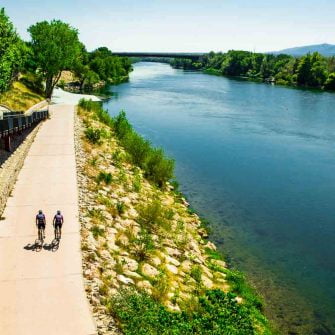 Ebro river in Tortosa
Ebro river in Tortosa Cardó Mountain Range
Cardó Mountain RangeWhen to visit Terres de l’Ebre?
The best time to visit Terres de l’Ebre is between March and October. Typically, Catalonia bike tours are most often run during these months.
Temperatures peak in late summer, early autumn at around 25°C and it’s typically a warm and temperate climate.
The winters aren’t especially cold (except at the top of the mountains!) but the region can get windy.
The rainfall for this area is low all year round, with an average yearly rainfall of about 517mm.
There is an extremely low possibility of snow falling. So although you could plan your trip over winter, the best weather is between spring and autumn.
This is a great weather app for Catalonia when you’re planning rides.
Any tips for riding in Terres de l’Ebre?
Read the tips below before heading off on your cycle tour in Catalonia.
Respect your environment
The rules of the road for cyclists are the same across Spain, but most of it is common sense, like having working brakes, using lights when it’s dark, and wearing a helmet. Remember that you ride on the right-hand side of the road here, and you cannot ride in bus lanes. You can find the Spanish highway code here.
Be aware that this region is part of the UNESCO Biosphere so it’s important that you clean up after yourself and leave no trace. Make sure you don’t litter and keep disturbance to the landscape to a minimum.
What to bring
The only place it really gets cold is at the top of the mountains, so if you think you’ll be riding up there make sure you pack a jacket, something you can stuff in your jersey for the descents. Additionally, sun cream is a good idea, preferably something that won’t run when you sweat.
There are bike shops around if you do forget something but try and take as much as you can with you. No one wants to spend their holiday trying to source spare parts.
 Cardó
Cardó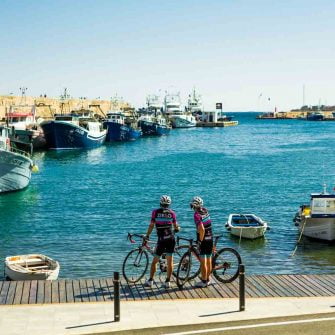 L’Ametlla de Mar port
L’Ametlla de Mar port Enjoying the Biosphere Reserve
Enjoying the Biosphere ReserveTraining
The terrain depends entirely on where you choose to base yourself, but if you want to ride in the mountains then we would highly recommend getting some training in before you visit so it’s not too much of a shock to the system!
Public transport
Buses are quite limited in this rural area, but both the buses and trains do allow bicycles on. However, you will more often find people riding or driving between towns rather than using public transport. Hiring a car may be useful if you want to head to faraway parts of the region, but most of it can be accessed within a 100-kilometre bike ride so consider this when deciding where you base yourself.
Food and drink
With the proximity to the sea and the combination of olives, rice and wine-growing in the region, there are plenty of cuisines for you to try. The tourist board recommends some of the following dishes: Ribera rice (Arroz de Ribera), rice, cabbage and beans, delta oysters, eel and clotxa which is a bread emptied then stuffed with fish, garlic, onion and tomatoes or pastissets (sweet pastries). Whatever you try, it’s bound to taste extremely fresh!
Many of the routes we’ve shown you go through lots of different villages, so there will be chances to stock up on drinks and food as you ride. But, it’s best to be prepared, especially if you plan on heading into the mountains where there will be less chance of finding somewhere to stock up.
Culture and language
Terres de l’Ebre is part of Catalonia, and the language (Catalan) is different to Spanish. It’s worth brushing up on a bit before you go, but as they expect English speaking cycling tourists you may find you can hold a conversation in English with some residents. The people of Catalonia are often fluent in many languages such as French, but many also like to practice their English!
Terres de l’Ebre is brimming with culture and history, largely stemming from its involvement in the Civil War. However, it is full of artisans and creative people so you’ll see a lot of local artists on your visit, where perhaps you can pick up a little reminder of your trip!
How to get to Terres de l’Ebre
Terres de l’Ebre is easily accessed by car, train or plane. The nearest airports are in Reus and in Barcelona, (Josep Tarradellas Barcelona-El Prat Airport) and from the city, you can either hire a car to drive or catch a train to Terres de l’Ebre.
Bicycles are welcome on trains and buses, so you shouldn’t have any problem if you bring your own bike on holiday. The R16 line connects Barcelona to Terres de l’Ebre, but once you arrive there isn’t much in the way of public transport. Locals often use their bicycles or cars to get around.
A company called Hife can be used to connect you to the airport from Barcelona via shuttle bus. They run along the C-32 by Gava Mar, which is 15 minutes from the airport. Some hotels also offer airport transfers, so it’s best to check with your accommodation provider before booking.
Have you visited Terres de l’Ebre?
Tell us all about it in the comments below!
A big thank you to Anna for all her insights on cycling the Terres de l’Ebre region. We can’t wait to visit!
Got a question for Anna?
Fill out this form and we will send it to Anna. We aim to get you an answer within 24 hours wherever possible!
The contents of this website are provided for general information purposes only. It is not intended to amount to advice and you should not rely on it. You should carry out your own due diligence and risk assessments and take professional advice. Views expressed by interviewees or other users of this website do not necessarily represent our views. We make no representations, warranties or guarantees, whether express or implied, that the content on our website is accurate, complete or up to date. If you use any information or content on this website, download from, or otherwise obtain content or services through our website, it is entirely at your own discretion and risk. Epic Road Rides Ltd disclaims all liability and responsibility arising from any reliance placed on the information and content on this website. Find out more here.

